Integrals Class 12 Important Questions with Solutions Previous Year Questions
Question 1.
Find ∫
Answer: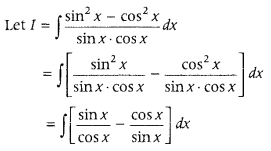
= ∫(tan x – cot x) dx
= ∫ tan x dx – ∫ cot x dx
= log |sec x| – [- log|cosec x|] + C
= log |sec x| + log|cosec x| + C
= log |sec x ∙ cosec x| + C
Question 2.
Find ∫
Answer: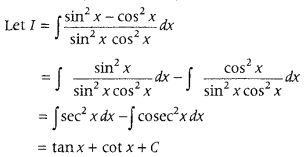
Question 3.
Find ∫
Answer: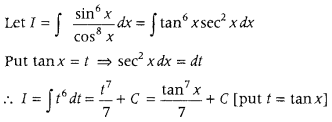
Question 4.
Evaluate ∫
Answer:
Let I = ∫
= ∫
= ∫(sec2x + cosec2x) dx
= ∫sec2 xdx + ∫ cosec2x dx
= tan x – cot x + C
Alternate Method:
On dividing the numerator and denominator by cos4 x, we get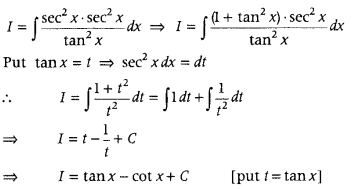
Question 5.
Evaluate ∫cos-1(sin x) dx. (Delhi 2014C)
Answer: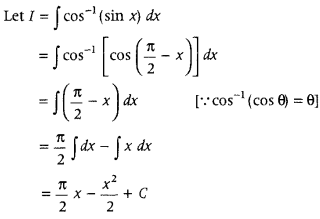
Question 6.
Write the anti-derivative of (3√x +
Answer: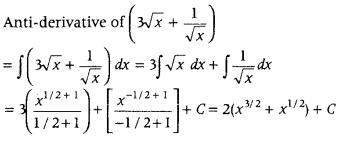
Question 7.
Evaluate ∫(1 – x)√x dx. (Delhi 2012)
Answer:
First, multiply the two functions and then use
∫xn dx =
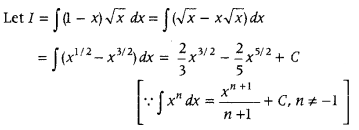
Question 8.
Given, ∫ex (tan x + 1) sec x dx = ex f(x) + C.
Write f(x) satisfying above. (All India 2012; Foregin 2011)
Answer:
Use the relation ∫ex [f(x) + f'(x)dx = ex f(x) + C and simplify it.
Given that ∫ex (tan x + 1) sec x dx = ex ∙ f(x) + C
⇒ ∫ ex (sec x + sec x tan x)dx = ex f(x) + C
⇒ ex . sec x + C = ex f(x) + C
[∵ ex {f(x) + f’(x)}dx = ex f(x) + C and here
On comparing both sides, we get
f(x) = sec x
Question 9.
Evaluate ∫
Answer: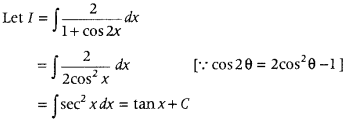
Question 10.
Write the value of ∫
Answer: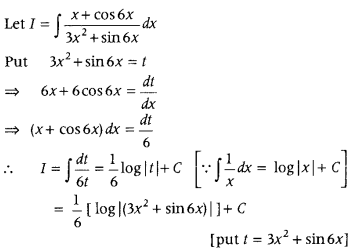
Question 11.
Write the value of ∫
Answer: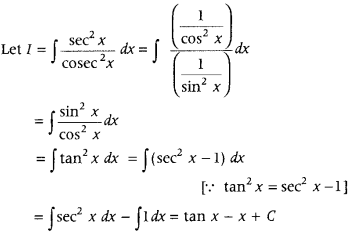
Question 12.
Write the value of ∫
Answer: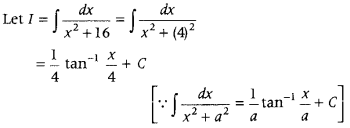
Question 13.
Write the value of ∫
Answer:
Let I = ∫
= ∫
= ∫(2 sec2 x – 3 sec x tan x) dx
= 2∫sec2x dx – 3∫sec x tan x dx
= 2 tan x – 3 sec x + C
Question 14.
Write the value of ∫ sec x(sec x + tan x)dx. (Delhi 2011)
Answer:
Let I = ∫sec x(sec x + tan x)dx
= ∫(sec2x + sec x tan x)dx
= ∫sec2 x dx + ∫sec x tan x dx
= tan x + sec x + C
Question 15.
Evaluate ∫
Answer:
Question 16.
Evaluate ∫
Answer:
Question 17.
Evaluate ∫
Answer: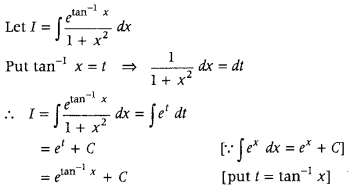
Question 18.
Evaluate ∫ (ax + b )3 dx. (All India 2011)
Answer: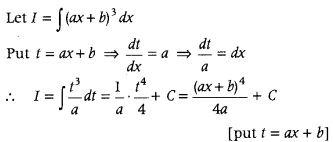
Question 19.
Evaluate ∫
Answer: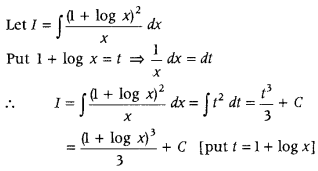
Question 20.
Evaluate ∫
Answer: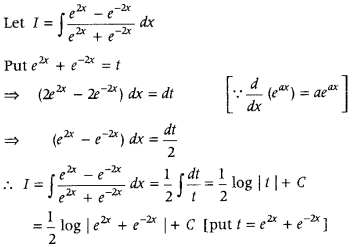
Question 21.
Evaluate ∫
Answer: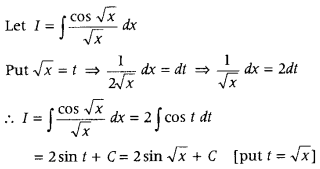
Question 22.
Evaluate ∫
Answer: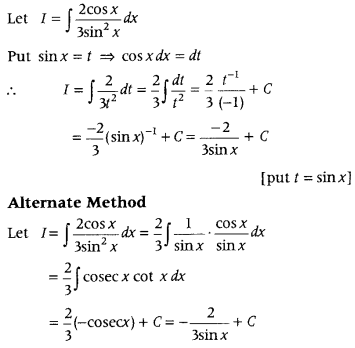
Question 23.
Evaluate ∫
Answer:
First, factorise numerator and cancel out common factor from numerator and denominator and then integrate.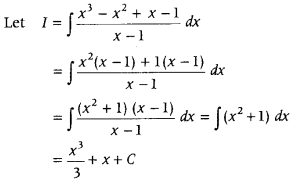
Question 24.
Write the value of ∫
Answer:
Let I = ∫
= ∫
= ∫ sec2x dx – ∫ sec x tan x dx
= tan x – sec x + C
Question 25.
Evaluate ∫
Answer:
– 2 cosec x + C
Question 26.
Evaluate ∫
Answer: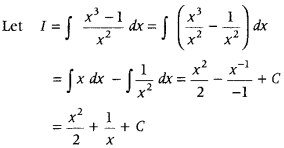
Question 27.
Evaluate ∫sec2 (7 – 4x) dx. (Delhi 2010; All India 2010)
Answer: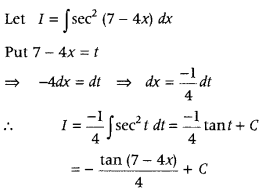
Question 28.
Evaluate ∫
Answer:
Question 29.
Evaluate ∫ 2x dx. (All India 2010C)
Answer:
Let I = ∫ 2x dx =
[∵ ∫ax dx =
Question 30.
Find ∫
Answer: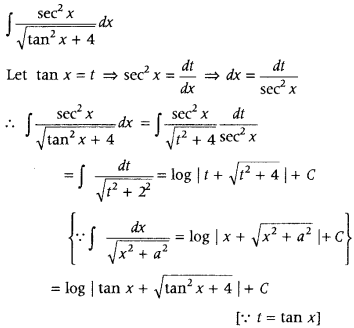
Question 31.
Find: ∫
Answer:
Question 32.
Find: ∫ sin-1 (2x) dx. (Delhi 2019)
Answer: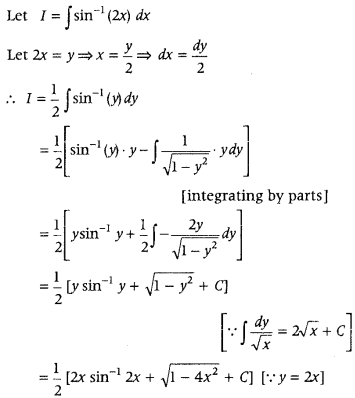
Question 33.
Find the values of ∫
Answer: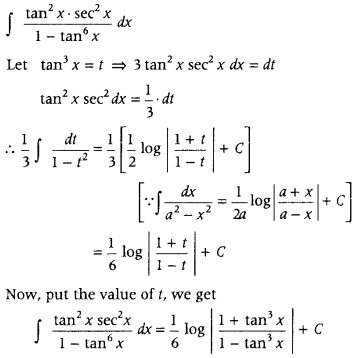
Question 34.
Find the value of ∫ sin x ∙ log cos x dx. (Delhi 2019)
Answer:
∫ sin x ∙ log cos x dx
Put cos x = t ⇒ – sin x dx = dt
∴ – ∫ log t dt ⇒ – ∫ (log t) ∙ 1 dt
⇒ [log t ∫ 1 dt – ∫ {
⇒ [(log t) ∙ t – ∫
⇒ – [t ∙ log t – ∫ 1 dt]
⇒ – [t log t – t] + C
⇒ – t ∙ log 1 + 1 + C
⇒ cos x log cos x + cos x + C
Question 35.
Find ∫
Answer: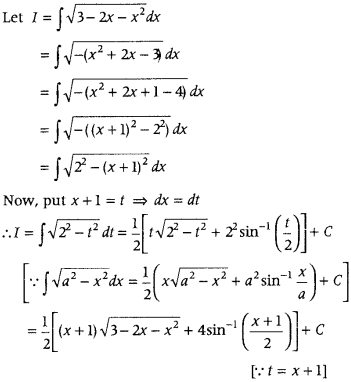
Question 36.
Find ∫
Answer: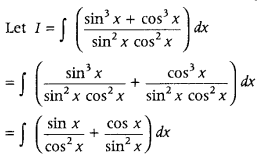
= ∫ [(tan x ∙ sec x ) + (cot x ∙ cosec x)] dx
= ∫ sec x ∙ tan x dx + ∫ cot x ∙ cosec x dx
= sec x + (- cosec x) + C = sec x – cosec x + C
Question 37.
Find ∫
Answer: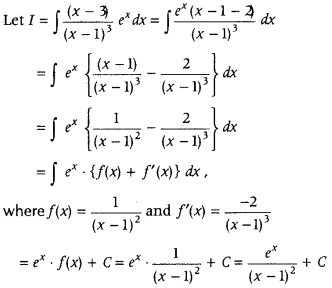
Question 38.
Find ∫
Answer: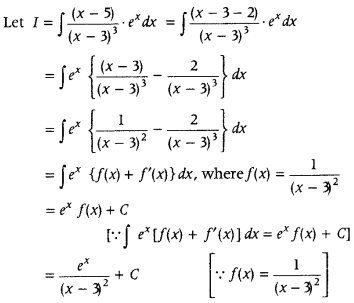
Question 39.
Evaluate ∫
Answer:
Question 40.
Find: ∫
Answer:
Let I = ∫
= ∫
= 3 ∫sec2 x dx – 5 ∫ sec x tan x dx
= 3 tan x – 5 sec x + C
Question 41.
Find ∫
Answer: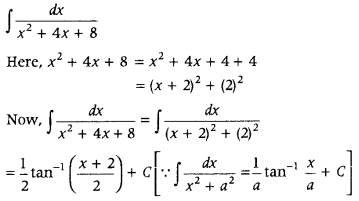
Question 42.
Find ∫
Answer:
Question 43.
Find: ∫
Answer:
Let I = ∫
Also, let 3x + 5 = A
3x + 5 = A(2x + 3) + B …….. (ii)
On comparing the coefficient of x, we get
2A = 3 ⇒ A =
and on comparing the constant term, we gct
B = 5 – 3A ⇒ B = 5 – 3
From Eq. (ii). we get
3x + 5 =
From Eqs. (i) and (iii), we get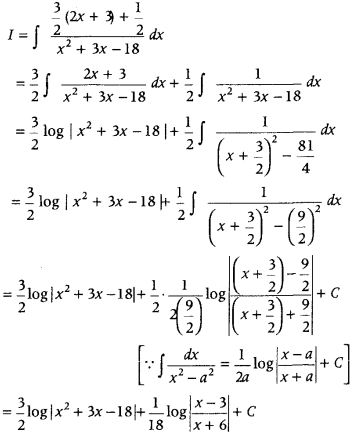
Question 44.
Find the value of ∫
Answer:
Let I = ∫
Put sin x = t ⇒ cos x dx = dt
1 = 2A + tA + B + Bt
1 = 1(2A + B) + t(A + B)
On comparing the coefficients of I and constant term on both sides, we get
2A + B = 1 and A + 8 = 0
⇒ A = 1 and B = – 1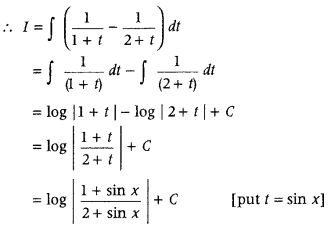
Question 45.
Find ∫
Answer: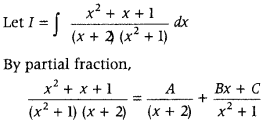
⇒ x2 + x + 1 = A(x2 + 1) + (Bx + C) (x + 2)
Putting x = – 2
4 – 2 + 1 = A(5) + 0 ⇒ 5A = 3 ⇒ A =
Putting x = 0,
0 + 0 + 1 = A(0 + 1) + (0 + C) (0 + 2)
⇒ 1 = A + 2C ⇒ 1 =
and putting x = 1,
⇒ 1 + 1 + 1 = 2A + (8 + C) (3)
⇒ 3 = 2A + 3(B + C)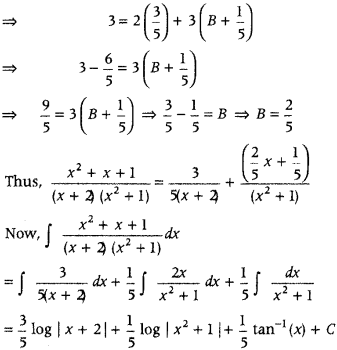
Question 46.
Find ∫
Answer: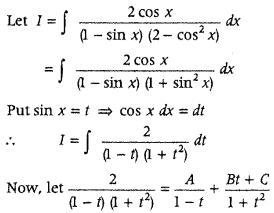
⇒ 2 = A(1 + t2) + (Bt + C) (1 – t)
Putting t = 1 in Eq. (i), we get
2 = 2A ⇒ A = 1
Putting t = 0 in Eq. (1). we get
2 = A + C ⇒ 2 = 1 + C ⇒ C = 1
Putting t = – 1 in Eq. (1), we get
2= 2A + (- B + C)
⇒ 2 = 2 – 2B + 2
⇒ 2B = 2 ⇒ B = 1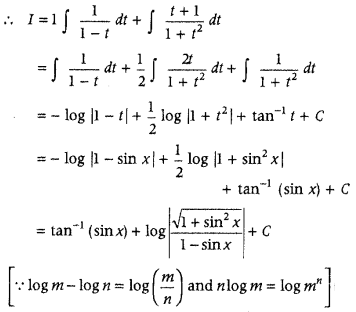
Question 47.
Find ∫
Answer: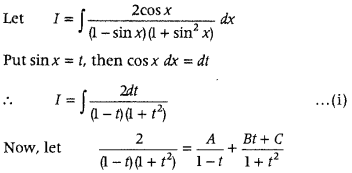
⇒ 2 = (1 + t2)A + (1 – t) (Bt + C)
⇒ 2 = (1 + t2)A + (Bt + C – Bt2 – Ct)
⇒ 2 = t2 (A – B) + t(B – C) + (A + C)
On comparing the coefficients of like powers of t, we get
A – B = 0; B – C = 0 and A + C = 2
⇒ A = B; B = C and A + C = 2
⇒ A = B = C = 1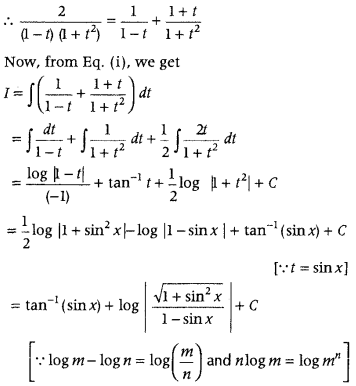
Question 48.
Find ∫
Answer:
⇒ 4 = A(x2 + 4) + (Bx + C) (x – 2)
⇒ 4 = x2 (A + B) + x(- 2B + C) + 4A – 2C
On equating the coefficients of x2, x and constant form both sides, we get
A + B = 0 ……. (i)
– 2B + C = 0 ……. (ii)
and 4A – 2C = 4 …….. (iii)
On solving Eqs. (i), (ii) and (iii), we get
A = 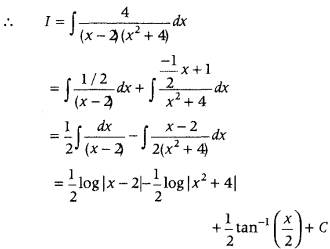
Question 49.
Find ∫
Answer: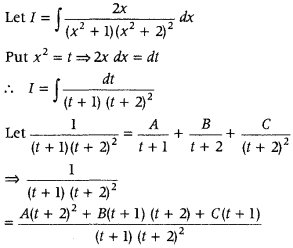
⇒ 1 = A(t + 2)2 + B(t + 1) (t + 2) + C(t + 1)
⇒ 1 = A(t2 + 4 + 4t) + B(t2 + 2t + t + 2) + C(t + 1)
⇒ 1 = A(t2 + 4t + 4) + B(t2 + 3t + 2) + C(t + 1)
⇒ 1 = t2 (A + B) + t(4A + 3B + C) + 4A + 2B + C
On comparing the coefficients of 2, and the constant term from both sides, we get
A + B = 0
4A + 3B + C = 0 ……. (ii)
and 4A + 2B + C = 1 …….. (iii)
From Eq. (1), A = – B
Put the value of A in Eqs. (ii) and (iii), we get
– 4B + 3B + C = 0
⇒ – B + C = 0
⇒ B – C = 0 ……. (iv)
and – 4B + 2B + C = 1
⇒ – 2B + C = 1
⇒ 28 – C = – 1
Now, from Eqs. (iv) and (y), we get
– B = 1 ⇒ B = – 1
∴ A = 1 and C = – 1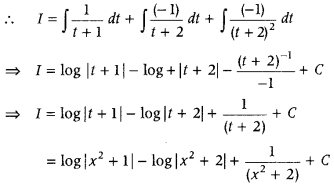
Question 50.
Find ∫
Answer: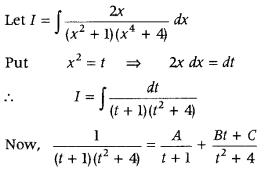
⇒ 1 = A(t2 + 4) + (Bt + C) (t + 1)
⇒ 1 = A(t2 + 4) + (Bt2 + Bt + Ct + C)
⇒ 1 = t2(A + B) +t(B + C) + (4A + C)
On comparing the coefficients of t2, t and constant term from both sides, we get
A + B = 0
B + C = 0 ……… (ii)
4A + C = 1 …….. (iii)
From Eqs. (i) and (ii), we get
A – C = 0 …… (iv)
From Eqs. (iii) and (iv), we get
5A = 1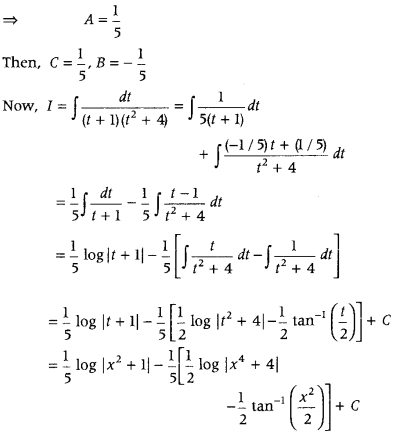
Question 51.
Find ∫
Answer: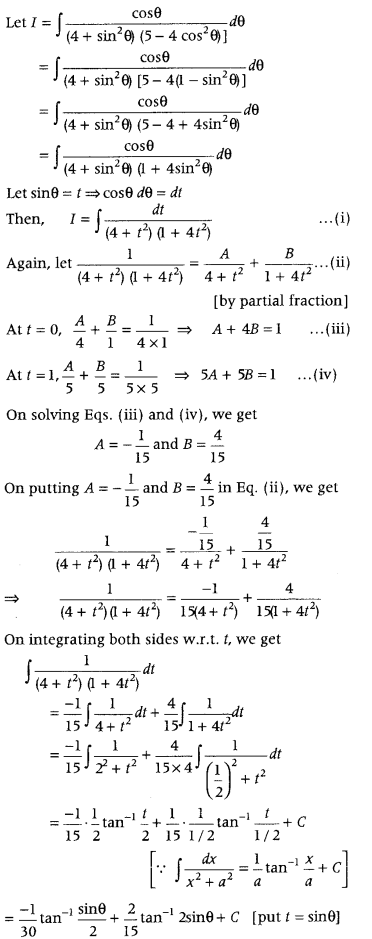
Question 52.
Find ∫
Or
Find ∫
Answer:
Question 53.
Find ∫
Answer: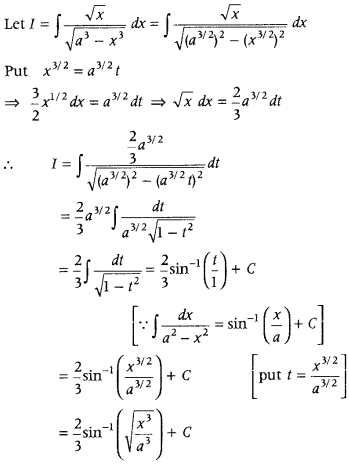
Question 54.
Find ∫(x + 3)
Answer:
First, use the method for integral of the form
∫(px + q)
consider (px + q) = A
simplify and get the values of A and B.
Further, simplify the integrand and use the formula
Let I = ∫(x + 3)
Given integral is the form of
∫ (px + q)
Let (x + 3) = A
⇒ x + 3 = A(- 4 – 2x) + B
⇒ x + 3 = (- 4A + B) – 2Ax
On comparing the coefficients of x and constant terms, we get
– 2A = I
⇒ A = –
and – 4A + B = 3 ⇒ 2 + B = 3 ⇒ B = 1 …….. (1)
Thus. (x + 3) = –
Now, given integral becomes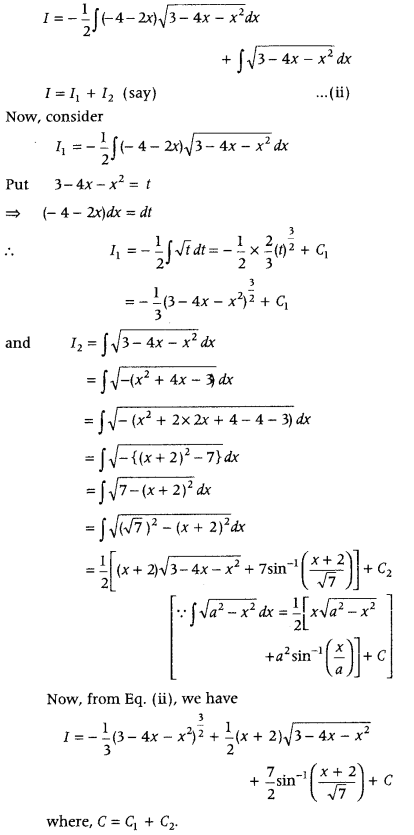
Question 55.
Evaluate ∫
Answer:
First, use the partial traction ¡n the given integrand,
i.e. write =
Simplify it and get the values of constants A, B and C.
Further, integrate it to get the result.
Let I = ∫
By using partial fraction method, we get
⇒ x2 + x + 1 = A(x2 + 1) + (Bx + C) (x + 2)
⇒ x2 + x + 1 = x2 (A + B) + x(2B + C) + (A + 2C)
On comparing the coefficients of x2, x and constant terms both sides, we get
A + B = 1 ……. (ii)
2B + C = 1 …….. (iii)
and A + 2C = 1 ……. (iv)
On substituting the value ofBfrom q. (ii) in Eq. (iii), we get
2(1 – A) + C = 1
⇒ 2 – 2A + C = 1
⇒ 2A – C = 1 ……. (v)
Question 56.
Find ∫
Answer: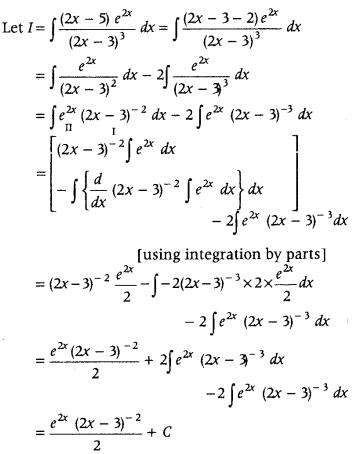
Question 57.
Find ∫ (2x + 5)
Answer: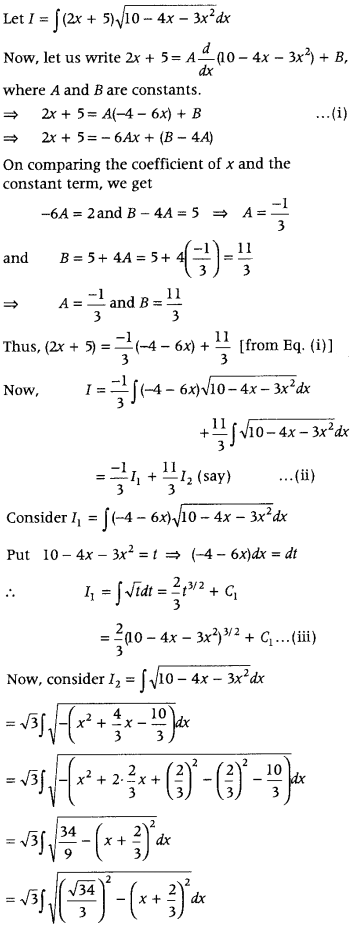
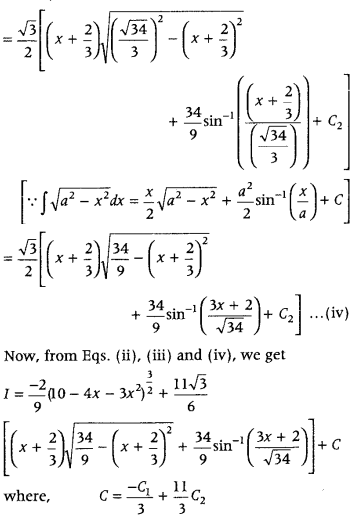
Question 58.
Find ∫
Answer: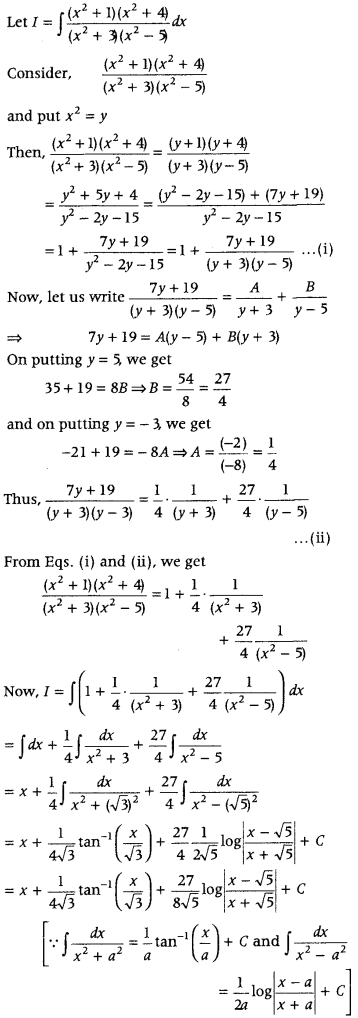
Question 59.
Evaluate ∫
Answer:
First, put x = sin t and then use integration by parts and simplify it.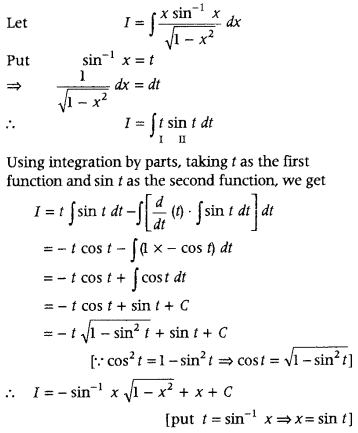
Question 60.
Find ∫
Answer:
First, simplify the integrand in such a form that numerator is in sin form and denominator is in cos form, Substitute cos x = t and then convert the given integrand in the form of t.
Now, use partial traction in the integrand and then integrate it. Further, substitute the value oft and get the required result.
Question 61.
Integrate w.r.t. x,
Answer: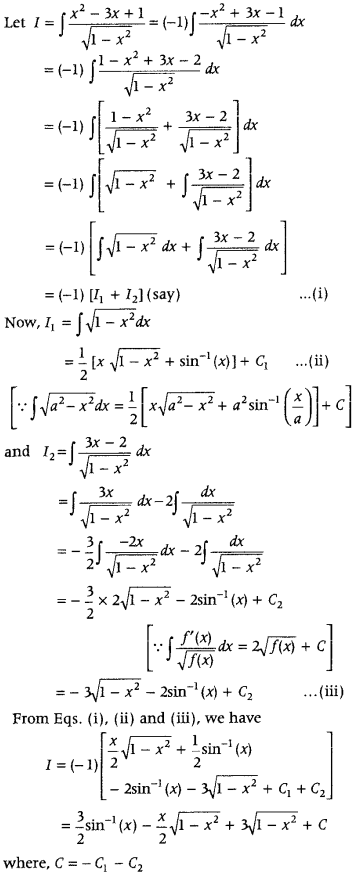
Question 62.
Evaluate ∫(3 – 2x)
Answer:![]()
Question 63.
Find ∫
Answer: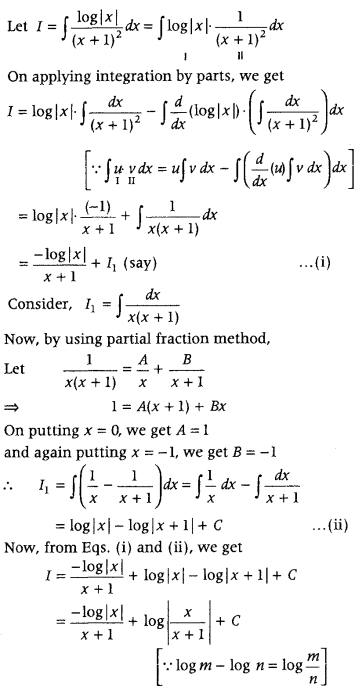
Question 64.
Evaluate ∫
Answer:
Let I = ∫
put x + a = t
⇒ dx = dt
∴ I = ∫
= ∫
[∵ sin(A – B) = sin A cos B – cos A sin B]
= ∫ cos 2a dt – ∫sin 2z . cos t dt
= cos 2a [t] – sin 2a log|sin(x + a)| + C1
[put t = x + a]
= x cos 2a – sin 2a log|sin(x + a)| + C
where, C = a cos 2a + C1
Question 65.
∫e2x sin(3x + 1) dx. (Foreign 2015)
Answer: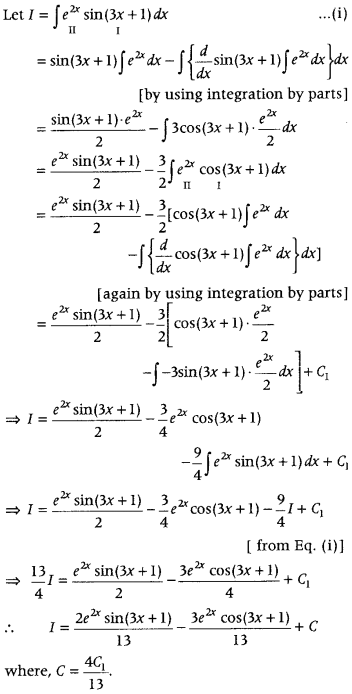
Question 66.
Evaluate ∫
Answer: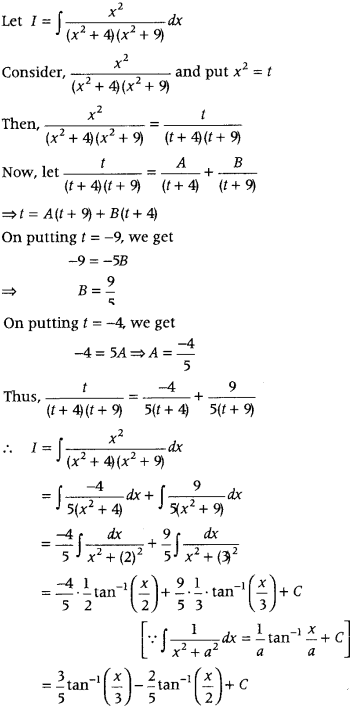
Question 67.
Find ∫
Answer: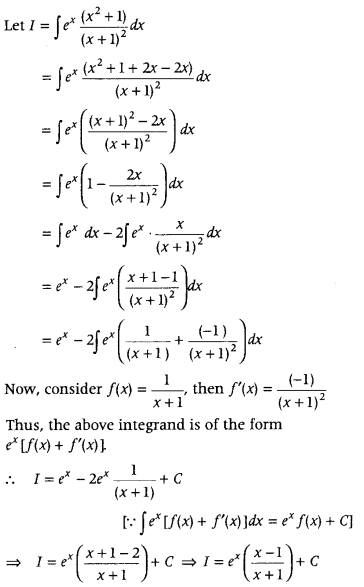
Question 68.
Evaluate ∫ (x – 3)
Answer:
Here, integrand is of the form (px – q)
Then integrate by using suitable method.
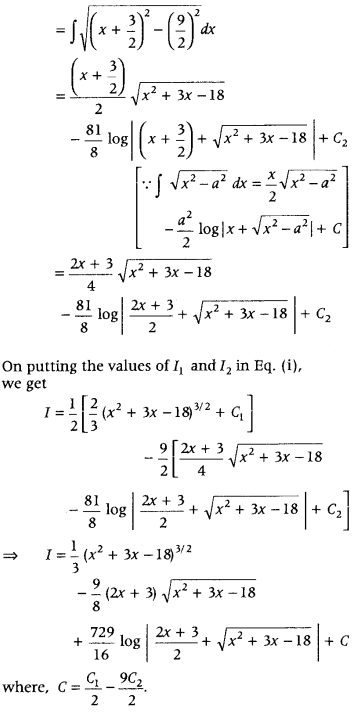
Question 69.
Evaluate ∫
Answer:
Question 70.
Evaluate ∫ (3x — 2)
Answer:
I = (x2 + x + 1)3/2 –
Question 71.
Find ∫
Answer:
Question 72.
Find ∫
Answer:
First, put x2 = t and use partial traction to write integrand in simplest form, Then integrate by using suitable formula.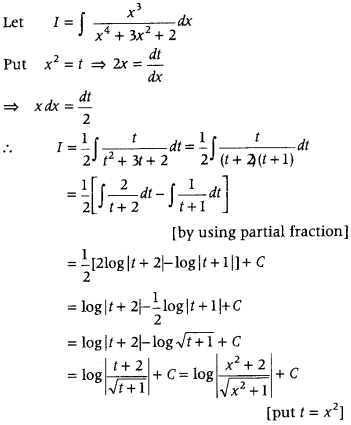
Question 73.
Evaluate ∫
Answer:
–
Question 74.
Evaluate ∫
Answer:
First, use a3 + b3 = (a + b)3 – 3ab(a + b)to write numerator of integrand in simplest form and then integrate by using suitable method.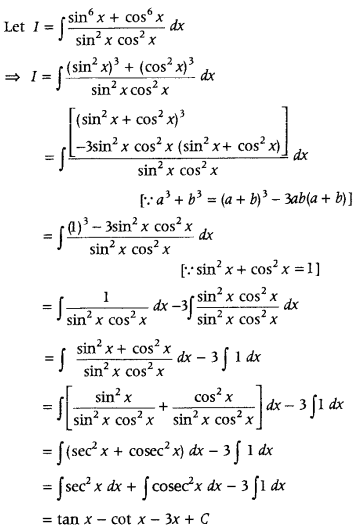
Question 75.
Evaluate ∫e2x
Answer:
First, use trigonometric formulae sin 2θ = 2 sin θ cos θ and cos 2θ = 1 – 2 sin2θ to write integrand in simplest form and then apply integration by parts to integrate.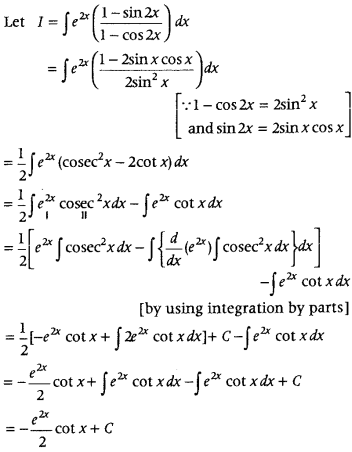
Question 76.
Evaluate ∫
Answer: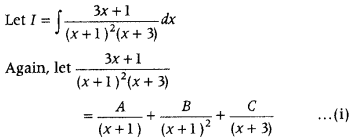
⇒ 3x + 1 = A(x + 1) (x + 3) + B(x + 3)
⇒ 3x + 1 = A(x2 + 4x + 3) + B(x + 3) + C(x2 + 1 + 2x)
⇒ 3x + 1 = (A + C)x2 + (4A + B + 2C)x + 3A + 3B + C
On comparing like powers of x from both sides, we get
A + C = 0
4A + B + 2C = 3
and 3A + 3B + C = 1
On solving, we get A = 2, B = – 1 and C = – 2
∴ Eq. (1) becomes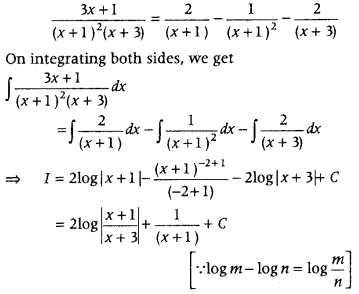
Question 77.
Evaluate ∫
Answer: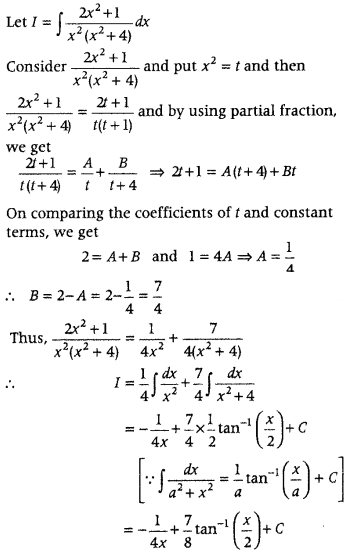
Question 78.
Evaluate ∫
Answer:
–
Question 79.
Evaluate ∫
Answer:
Question 80.
Evaluate ∫
Answer:
Question 81.
Evaluate ∫
Answer: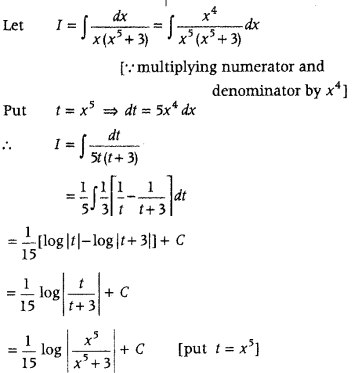
Question 82.
Evaluate ∫
Answer:
Question 83.
Evaluate ∫
Answer:
Question 84.
Evaluate ∫
Answer: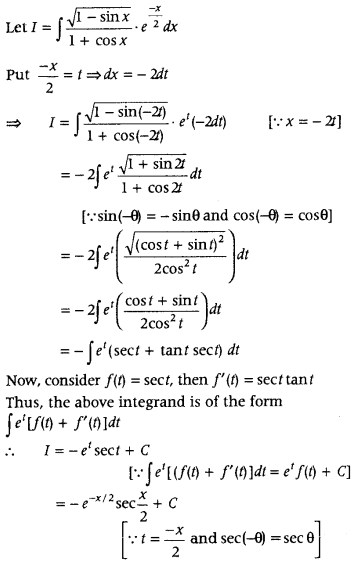
Question 85.
Evaluate ∫
Answer: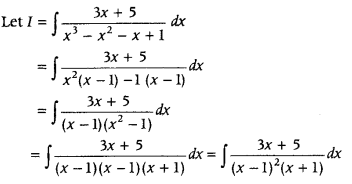
Question 86.
Evaluate ∫ sin x ∙ sin 2x ∙ sin 3x dx. (Delhi 2012)
Answer:
It is a product of three trigonometric functions. So, firstly we take two functions at a time and use the relation 2 sin A sin B = cos(A – B) – cos(A + B) and then integrate it.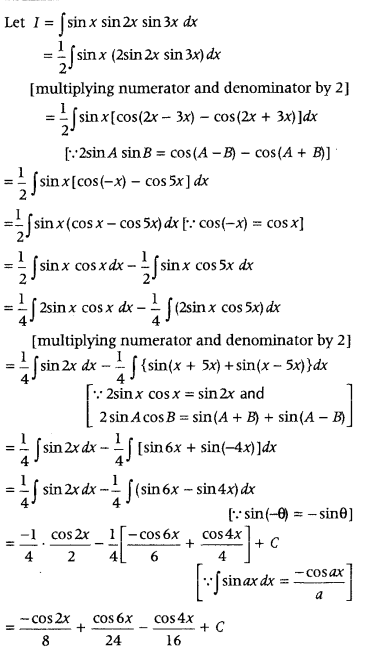
Question 87.
Evaluate ∫
Answer:
Here, denominator is a product of two algebraic functions. So, firstly we use partial fraction method and then integrate it.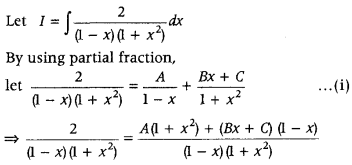
⇒ 2 = A(1 + x2) + (Bx + C)(1 – x)
⇒ 2 = A + Ax2 + Bx + C – Bx2 – Cx
⇒ 2 = (A – B)x2 + (B – C)x + (A + C)
On comparing coefficients of x2, x and constant
terms from both sides, we get
A – B = 0 ….. (ii)
B – C = 0 ….. (iii)
and A + C = 2 …… (iv)
On solving Eqs. (ii), (iii) and (iv), we get
A = 1, B = 1 and C = 1
Now, Eq. (i) become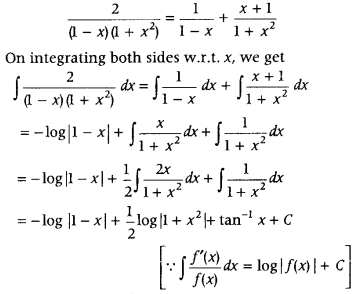
Question 88.
Evaluate ∫
Answer: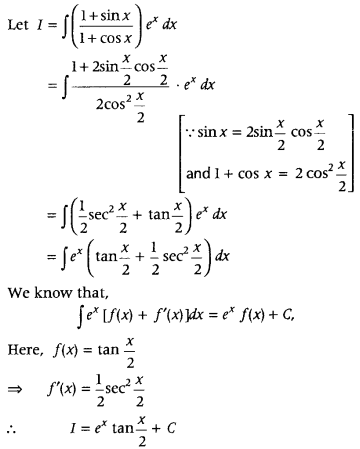
Question 89.
Evaluate ∫
Answer: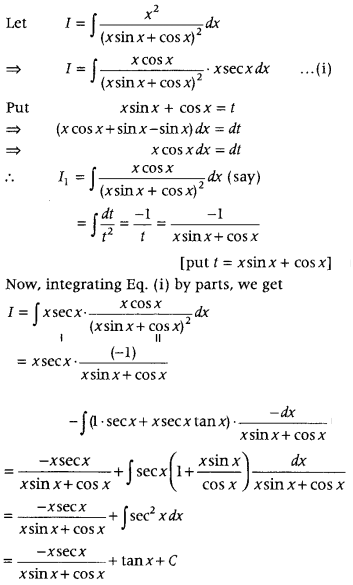
Question 90.
Evaluate ∫ e2x sin x dx. (Foreign 2011)
Answer:
Question 91.
Evaluate ∫
Answer:
3
Question 92.
Evaluate ∫
Answer:
First, divide numerator and denominator by x2 and reduce the integrand in standard form.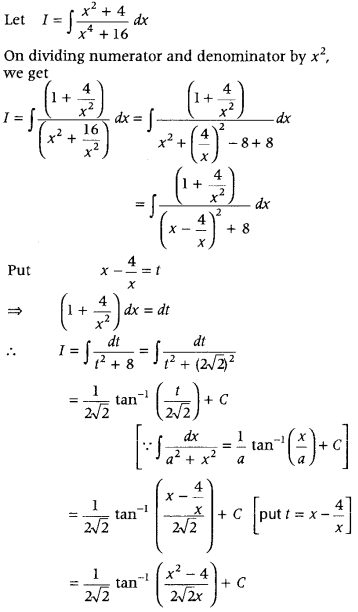
Question 93.
Evaluate ∫
Answer:
Question 94.
Evaluate ∫
Answer: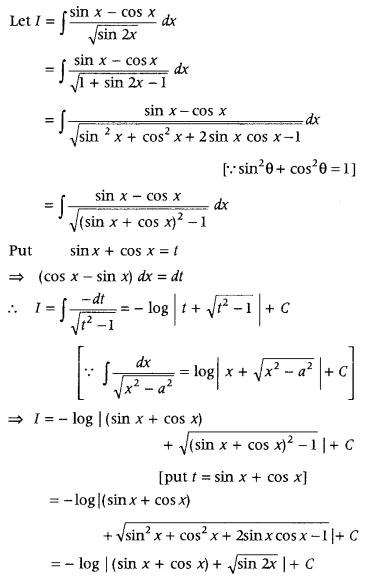
Question 95.
Evaluate ∫
Answer: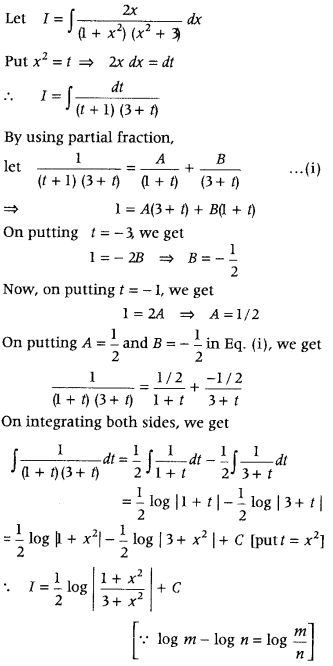
Question 96.
Evaluate ∫
Answer:
5
Question 97.
Evaluate ∫ e2x
Answer:
Question 98.
Evaluate ∫
Answer:
tan-1 x –
Question 99.
Evaluate ∫
Answer:
Use integration by parts, i.e.![]()
and choose 1st function with the help of ILATE procedure.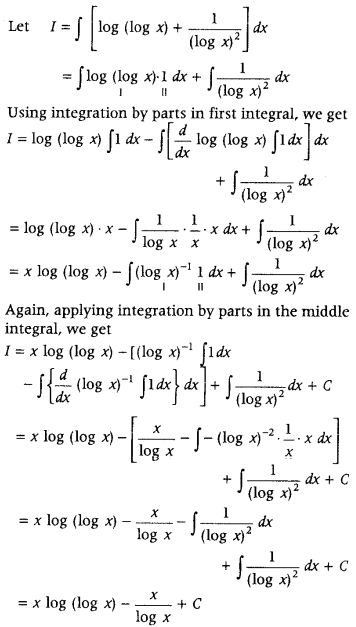
Question 100.
Evaluate ∫
Answer:
Question 101.
Evaluate ∫
Answer: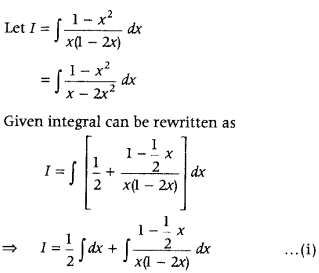
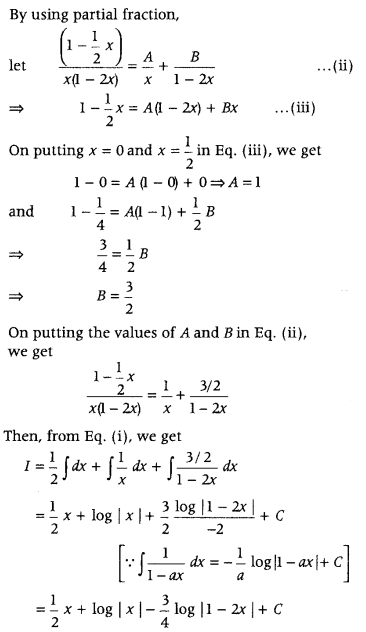
Question 102.
Evaluate ∫ ex
Answer: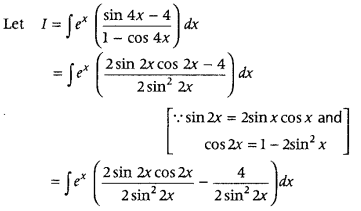
= ∫ex (cot 2x – 2 cosec2 2x) dx
We know that
∫ ex [f(x) + f'(x)] dx = ex f(x) + C
Here, f(x) = cot 2x
⇒ f'(x) = – 2 cosec2 2x
∴ I = ex cot 2x + C
Question 103.
Evaluate ∫
Answer:
First, divide numerator and denominator by cos4x to convert integrand in terms of tan x and then put tan x = t and convert integrand into standard form which can integrate easily.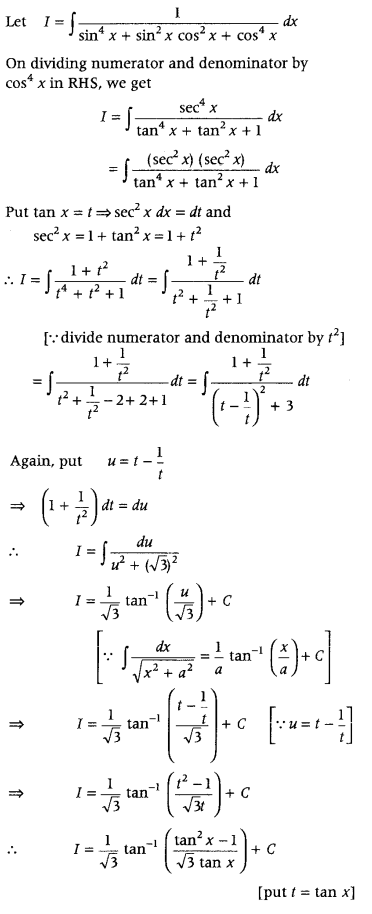
Question 104.
Evaluate ∫
Answer:
Question 105.
Evaluate ∫
Answer: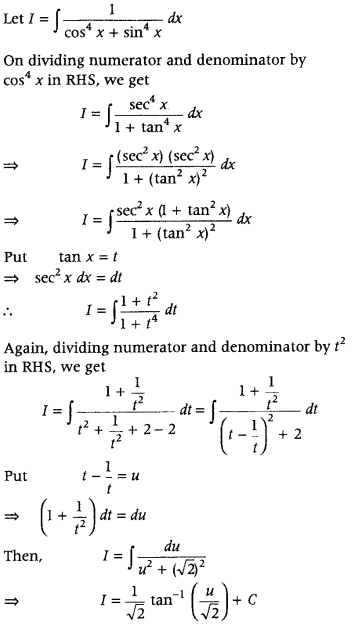
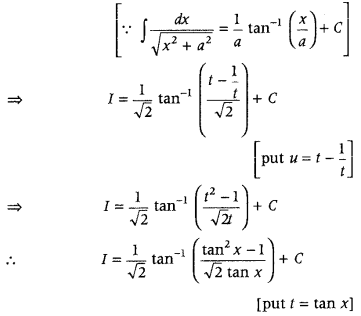
Question 106.
Find ∫
Answer:
–
Question 107.
Find ∫
Answer:
First, use the identity sin-1 x + cos-1 x = 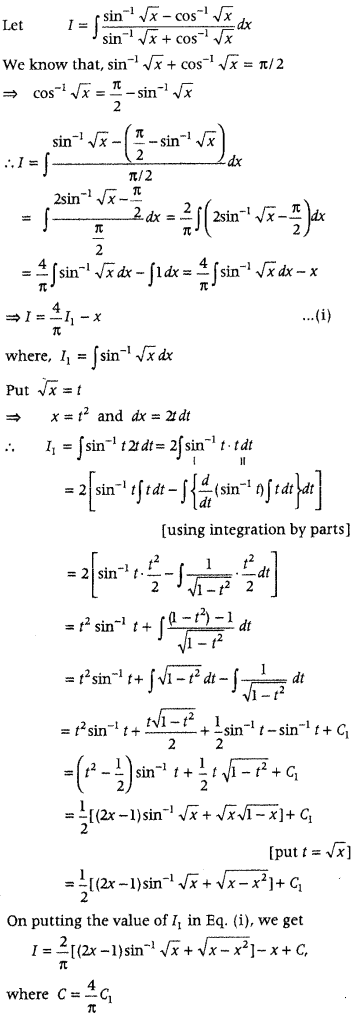
Question 108.
Find ∫
Answer:
⇒ x2 + x + 1 = A(x + 1) (x + 2) + B (x + 2) + C(x + 1)2
⇒ x2 + x + 1 = A(x2 + 3x + 2) + B(x + 2) + C(x2 + 2x + 1)
⇒ x2 + x + 1 = (A + C)x2 + (3A + B + 2C)x + (2A + 2B + C)
On comparing the coefficients of like powers from both sides, we get
A + C = 1,
3A + B + 2C = 1
and 2A + 2B + C = 1
On solving these equations, we get (1)
A = -2, B =1
and C = 3
From Eq. (i). we get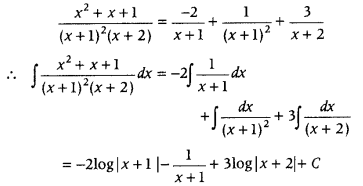
Question 109.
Find ∫
Answer: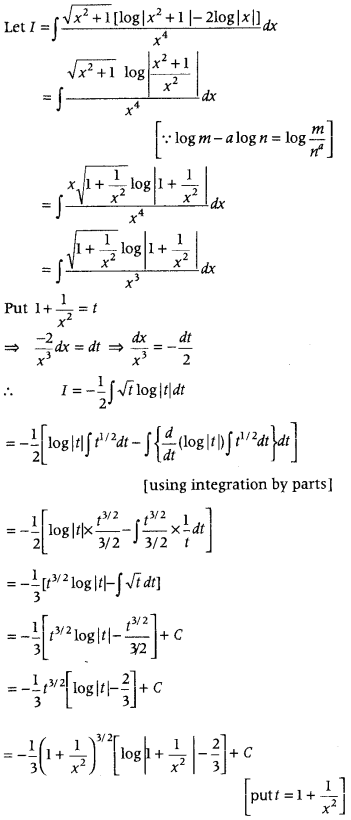
Question 110.
Evaluate ∫
Answer:![]()
Question 111.
Evaluate ∫
Answer:
Topic 2 Definite Integrals
Question 1.
Evaluate
Answer:
Question 2.
Evaluate
Answer: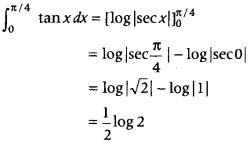
Question 3.
Evaluate
Answer: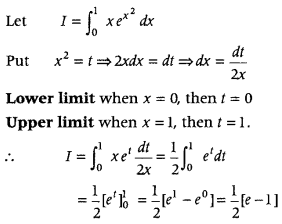
Question 4.
Evaluate
Answer: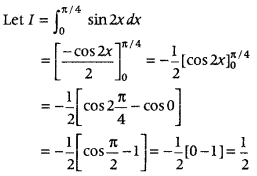
Question 5.
Evaluate
Answer: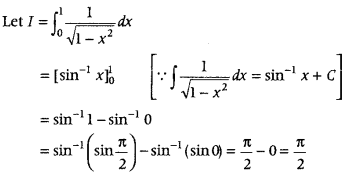
Question 6.
If
Answer: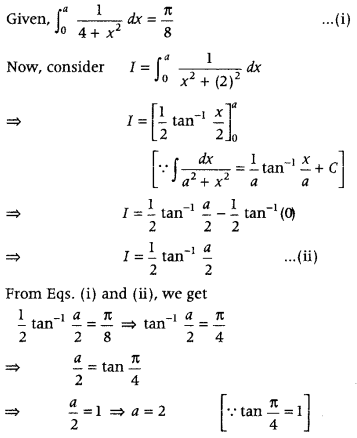
Question 7.
If f(x) =
Answer: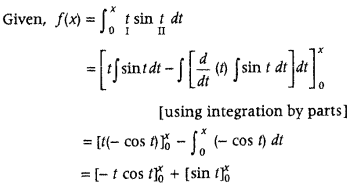
= – x cos x + 0 + sin x – 0
= sin x – x cos x
Thus. f(x) = sin x – x cos X
On differentiating both sides w.r.t. x, we get
f'(x) = cos x – [x
= cos x – [x (- sin x) + cos x]
= cos x + x sin x – cos x = x sin x
Question 8.
Evaluate
Answer: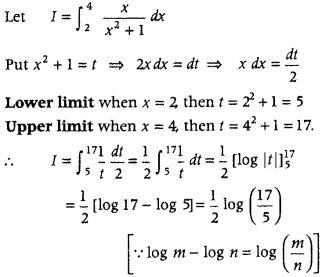
Question 9.
Evaluate
Answer: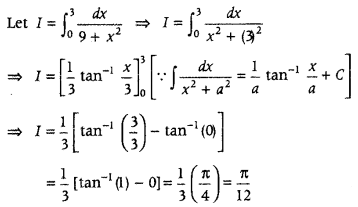
Question 10.
Evaluate
Answer:
Let I =
I = –
Now, consider, f(x) = cos x
then f'(x) = – sin x
Now, by using ∫ex [f(x) + f'(x) dx = ex f(x) + C,
we get I =
= –
= 0 + 1(1) = 1
Question 11.
Evaluate
Answer: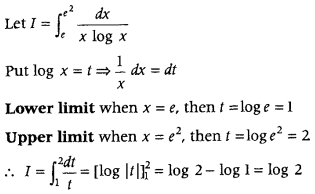
Question 12.
Evaluate
Answer: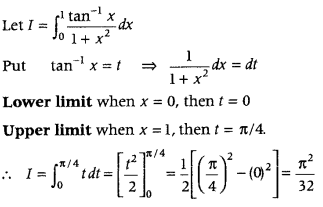
Question 13.
Evaluate
Answer: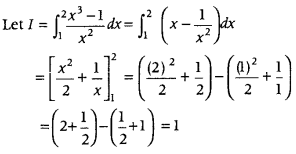
Question 14.
Evaluate
Answer:
Question 15.
Evaluate
Answer: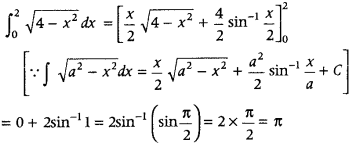
Question 16.
Write the value of
Answer:
Let I =
=
Put ex = t ⇒ ex dx = dt
Also, when x = 0, then t = 1 and when x = 1, then t = e
Now, I =
= tan-1 e – tan-1 1 = tan-1
Question 17.
Evaluate
Answer: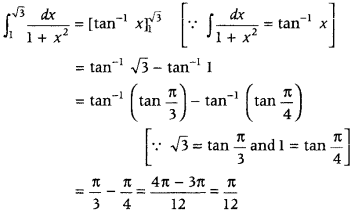
Question 18.
Evaluate
Answer:
log 2
Question 19.
Evaluate
Answer:
Question 20.
Evaluate
Answer:
Use, the property
let I =
consider, f(x) = sin3x. Then, f(-x) = sin3(-x)
= (-sinx)3 = -sin3x = -f(x)
⇒ f(x) is an odd function.
Thus, the given integrand is an odd function.
∴ I = 0
[∵
Question 21.
Write the value of the following integral
Answer:
0
Question 22.
Evaluate
Answer:
Let I =
Again, let f(x) = (1 – x2) sin x cos2 x
∴ f(- x) = [1 – (- x)2] sin (- x) cos2(- x)
= (1 – x2) (- sin x) cos2 x
= – (1 – x2) sin x cos2x
= – f(x)
∴ f(x) is odd function
∴ I = 0
[∵
Question 23.
Evaluate
Answer: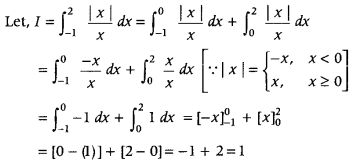
Question 24.
Prove that
Answer: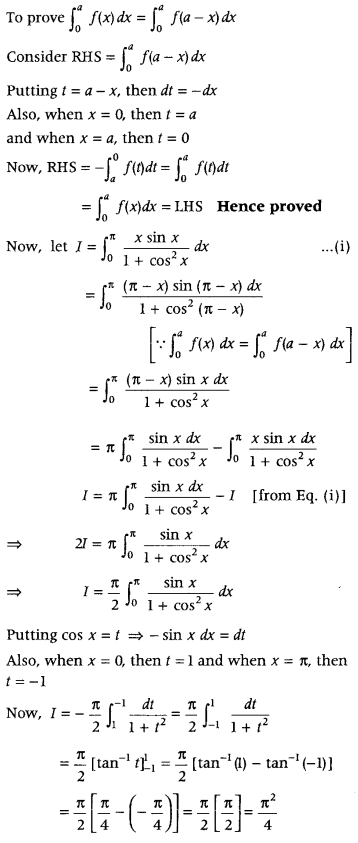
Question 25.
Prove that
Answer: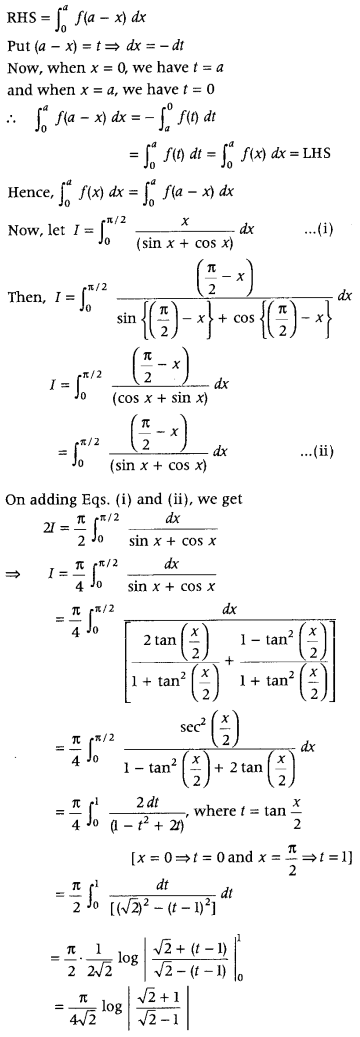
Question 26.
Evaluate
Answer:
Here, |x – 1|, |x – 2| and |x – 4| occurs.
Now, define the absolute function as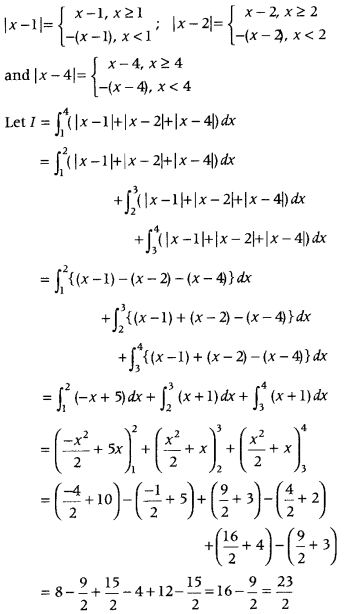
Question 27.
Evaluate
Answer: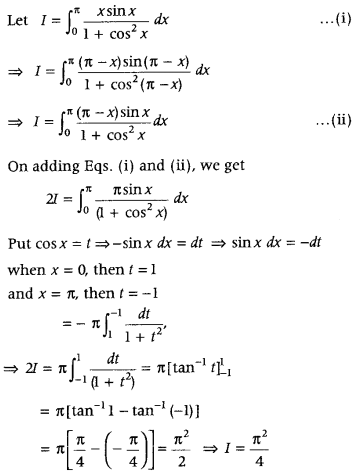
Question 28.
Evaluate
Answer: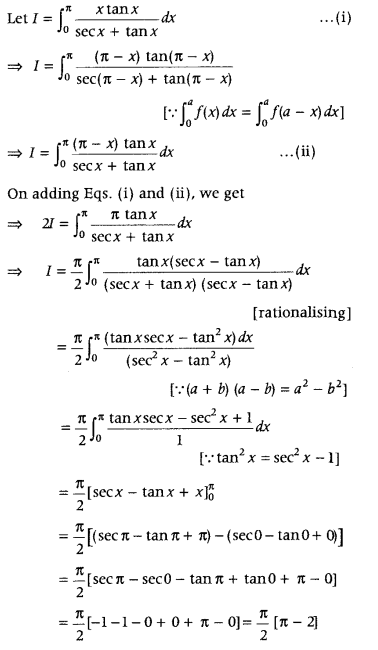
Question 29.
Evaluate
Answer:
First, define the absolute function in the given interval and then integrate it.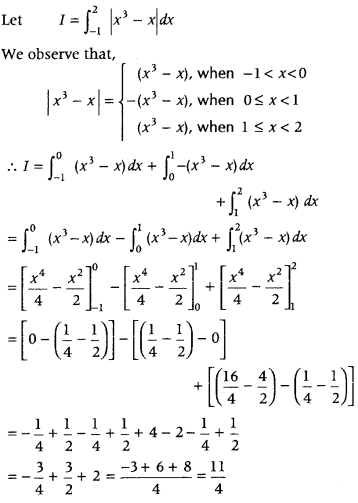
Question 30.
Evaluate
Answer: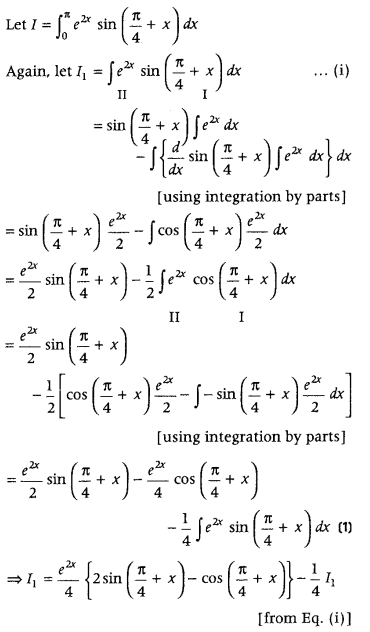
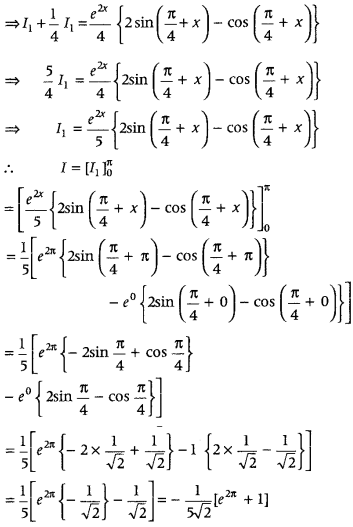
Question 31.
Evaluate
Answer: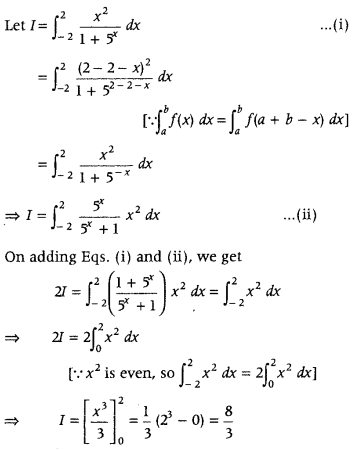
Question 32.
Evaluate
Answer: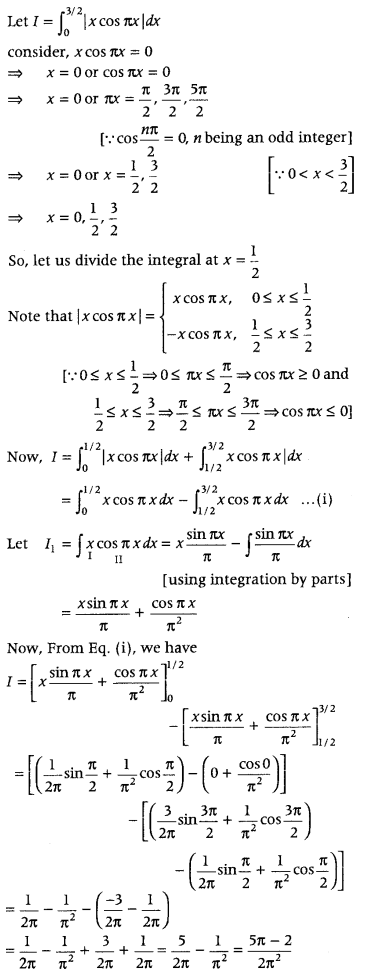
Question 33.
Evaluate
Answer: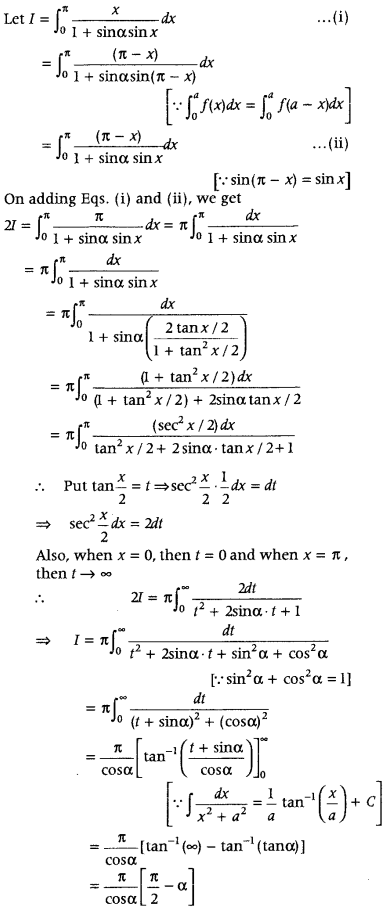
Question 34.
Evaluate
Answer: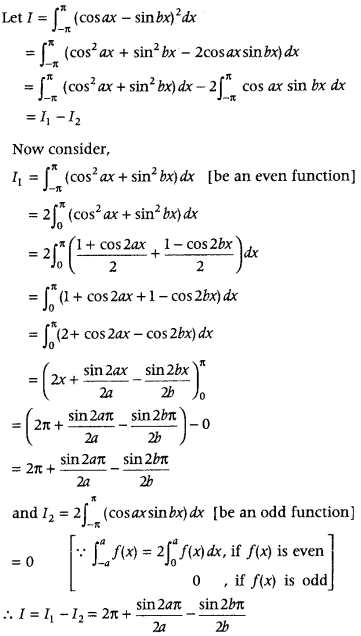
Question 35.
Find
Answer: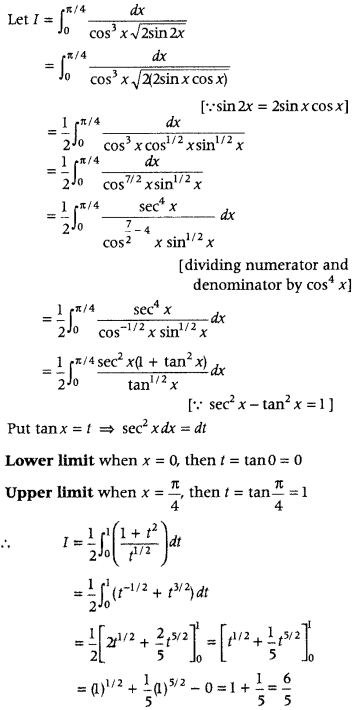
Question 36.
Evaluate
Answer: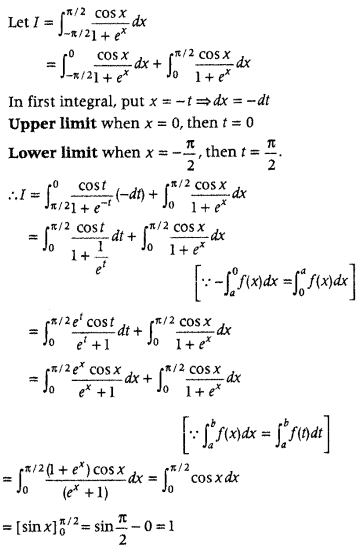
Question 37.
Evaluate
Answer: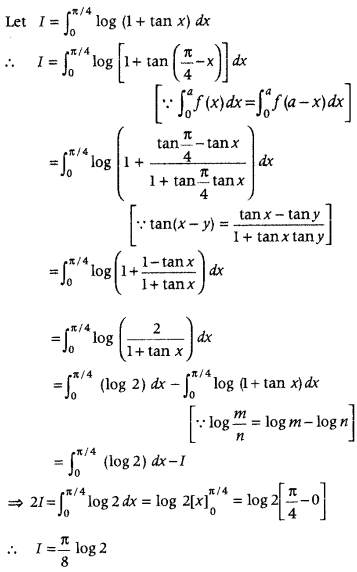
Question 38.
Evaluate
Answer:
Question 39.
Evaluate
Answer:
Let I = ![]()
= – x2 cos x + 2[x (sin x) – ∫1 . (sin x) dx]
[using integration by parts]
= – x2 cos x + 2(sin x + cos x)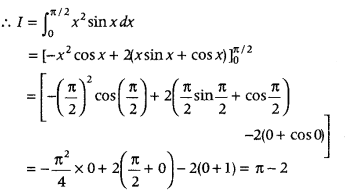
Question 40.
Prove that
Answer: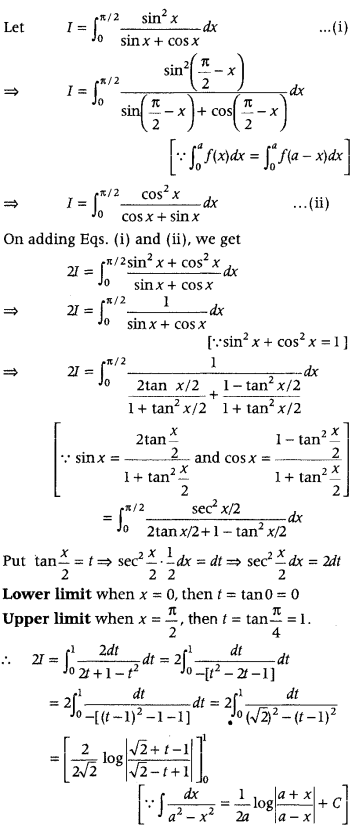
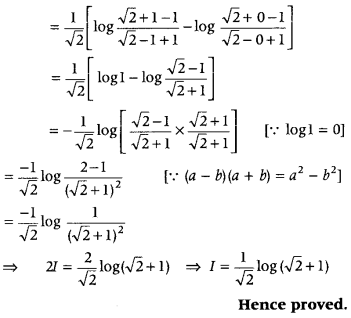
Question 41.
Evaluate
Answer:
First, we redefined the integrand of the integral between the given limits (2, 5). After that integrate and simplify it.
For, 2 ≤ x < 5, |x – 2| = (x – 2)
2 ≤ x < 3, |x – 3| = – (x – 3)
3 ≤ x < 5, |x – 3| = (x – 3)
and 2 ≤ x < 5, |x – 5| = (5 – x)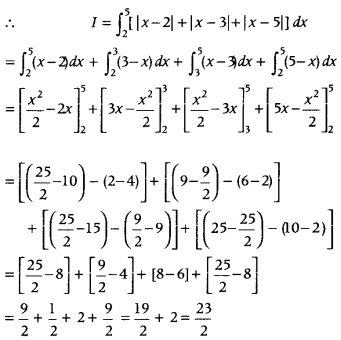
Question 42.
Evaluate
Answer:
Let I =
Here, redefined the given integrand in given interval (0, 4).
For, 0 < x < 4, |x| = x
0 < x ≤ 2, |x – 2| = – (x – 2)
2 ≤ x < 4, |x – 2| = (x – 2)
0 < x < 4, |x – 4| = – (x – 4)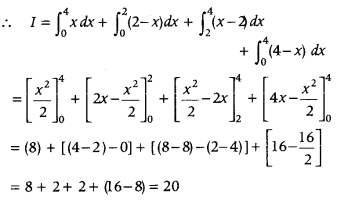
Question 43.
Evaluate
Answer:
5
Question 44.
Evaluate
Answer: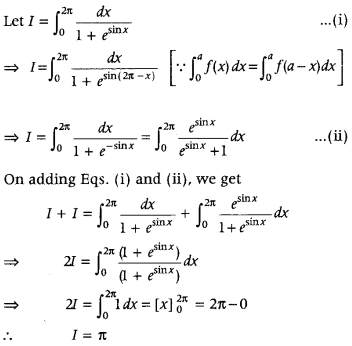
Question 45.
Evaluate
Answer:
Here, the power of numerator is greater than the power of denominator. So, first we add and subtract 1 in numerator and use formula (a2 – b2) = (a – b) (a + b)to simplify it and then integrate it.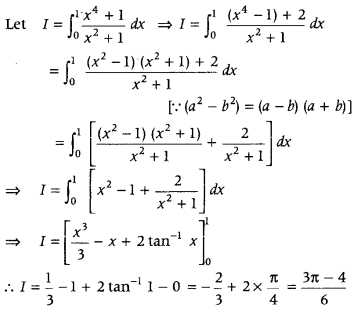
Question 46.
Evaluate
Answer: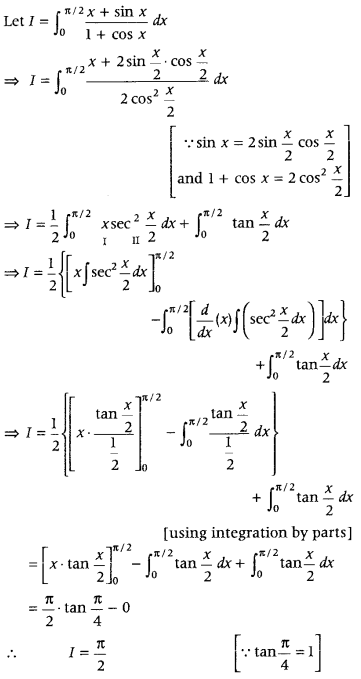
Question 47.
Evaluate
Answer:
Here, the power of numerator and denominator are same. So, first we divide numerator by denominator and write integrand in the form 
Question 48.
Evaluate
Answer: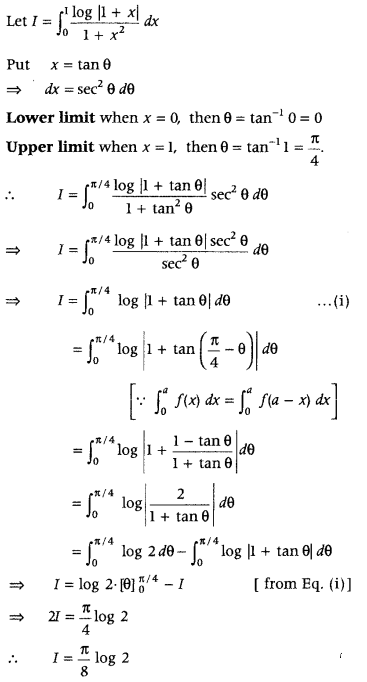
Question 49.
Evaluate
Answer:
Question 50.
Evaluate
Answer: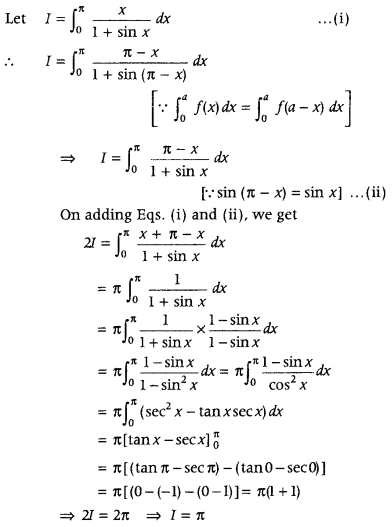
Question 51.
Find
Answer:
We have
On comparing with
a = 1, b = 3, nh = 3 – 1 = 2,
f(x) = x2 + 2 + e2x
Clearly, f(1) = 12 + 2 + e2 × 1 = 3 + e2
f(1 + h) = (1 + h)2 + 2 + e2(1 + h)
= 1 + 2h + h2 + 2 + e2 + 2h
= 3 + 2h + h2 + e2 ∙ e2h
f(1 + 2h) = (1 + 2h)2 + 2 + e2(1 + 2h)
= 1 + 4h + 4h2 + 2 + e2 + 4k
= 3 + 4h + 4h2 + e2 ∙ e4h
f(1 + (n – 1) h) = (1 + (n – 1) h)2 + 2 + e2(1 + (n – 1)h)
= 1 + 2(n – 1)h + (n – 1)2 h2 + 2 + e2 + 2(n – 1)h
= 3 + 2(n – 1) h + (n – 1)2 h2 + e2 ∙ e2(n – 1)∙h
∴ f(1) + f(1 + h) + f(a + 2h) + …… + f(1 + (n – 1)h)
= (3 + 3 + 3 + …… + 3 + 2h(1 + 2 + 3 + …… + (n – 1)2) + h2(12 + 22 + 32 + …… + (n – 1)2) + e2 (1 + e2h + ……. + e2h(n – 1))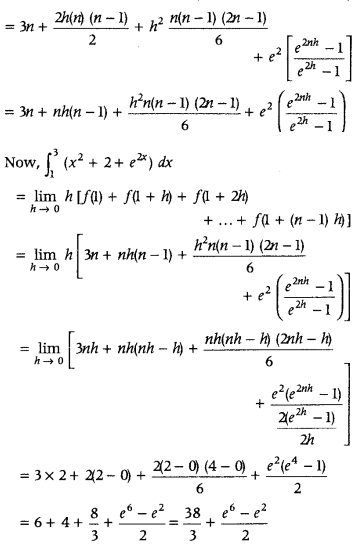
Question 52.
Evaluate
Answer: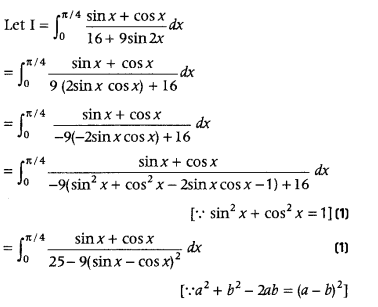
put sin x – cos x = t ⇒ (cos x + sin x)dx = dt
Also, when, x = 0, then t = -1 and when, x = 
Question 53.
Evaluate
Answer: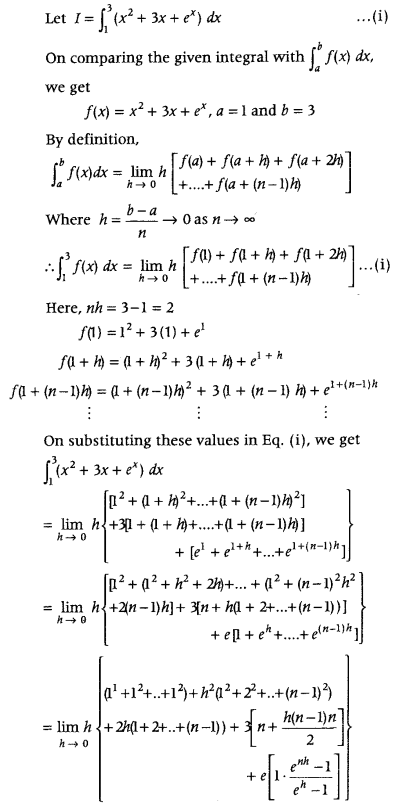

Question 54.
Evaluate
Answer:
Here, a = 1, b = 3, f(x) = 3x2 + 2x + 1
Now, nh = b – a = 3 – 1 = 2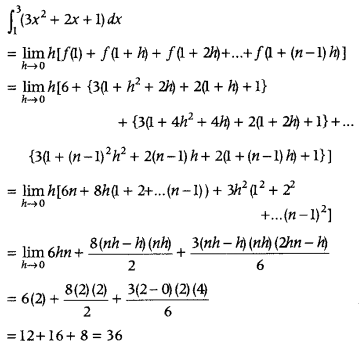
Question 55.
Evaluate
Answer: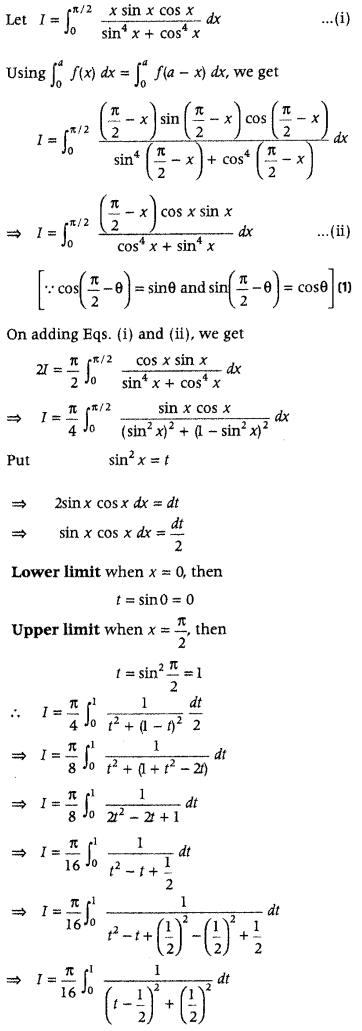
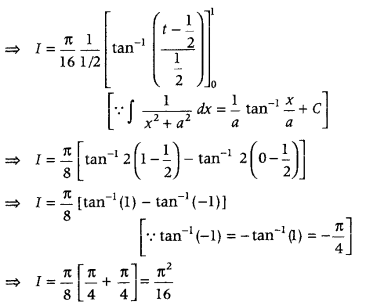
Question 56.
Evaluate
Answer: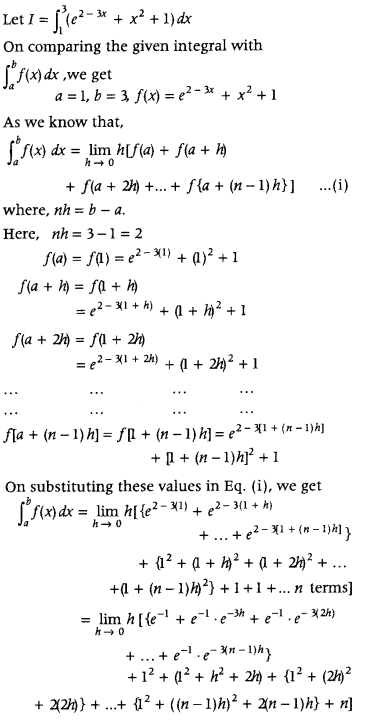
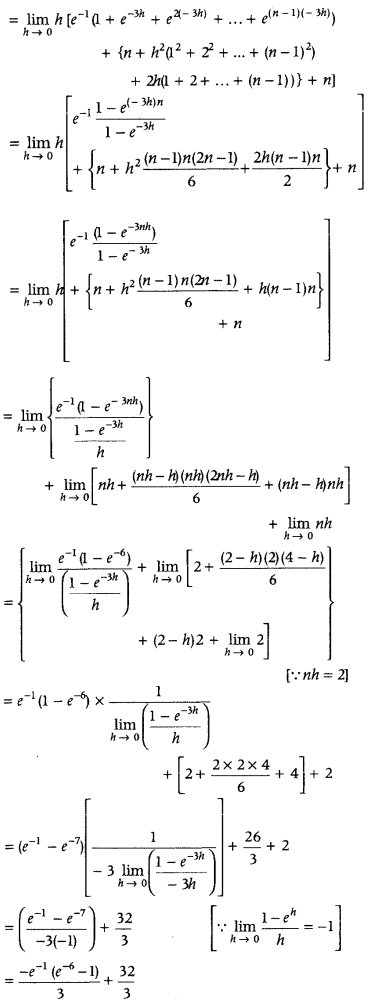
Question 57.
Evaluate
Answer:
First, convert the denominator in the form of (cos x – sin x), then put cos x – sin x = t and simplify it.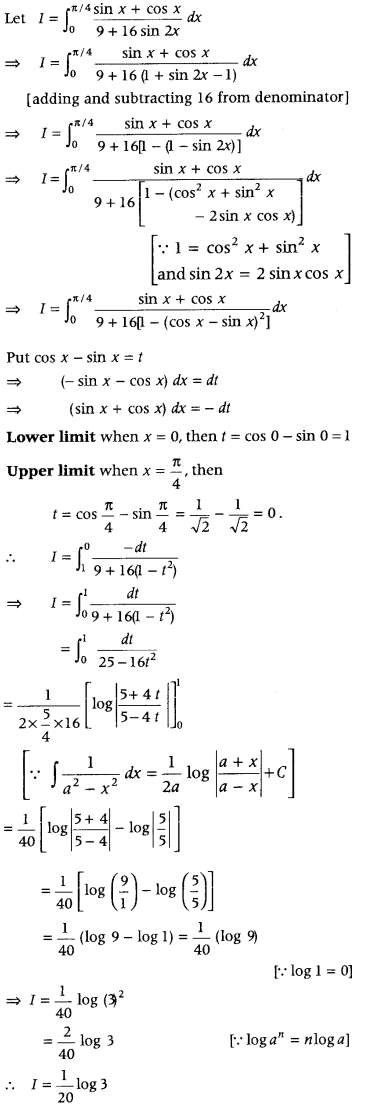
Question 58.
Evaluate
Answer: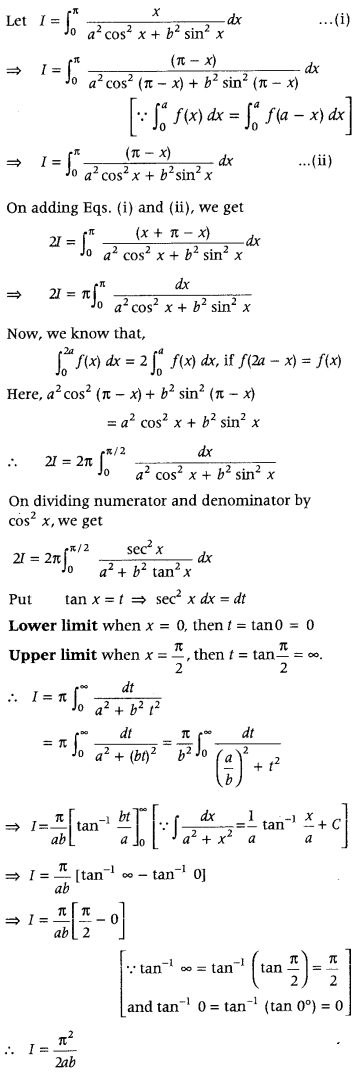
Question 59.
Evaluate
Answer: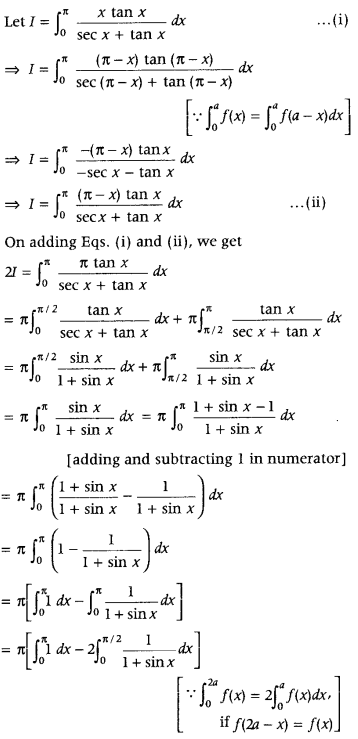
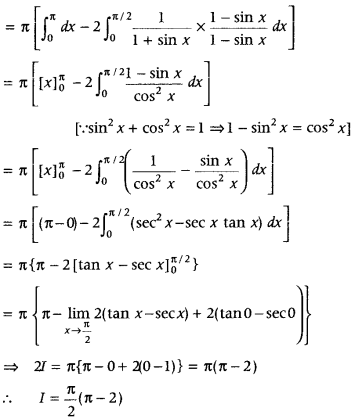
Question 60.
Evaluate
Answer: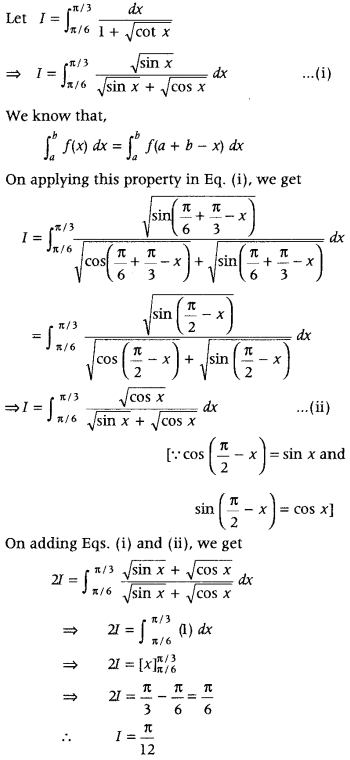
Question 61.
Evaluate
Answer:
Im limit of a sum, use the relation
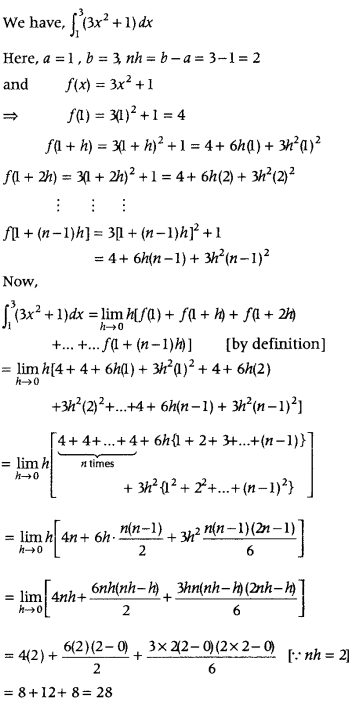
Question 62.
Evaluate
Answer:
we know that, by limit of a sum, we have
Question 62.
Evaluate
Answer:
we know that, by limit of a sum, we have
Question 63.
Prove that
Answer: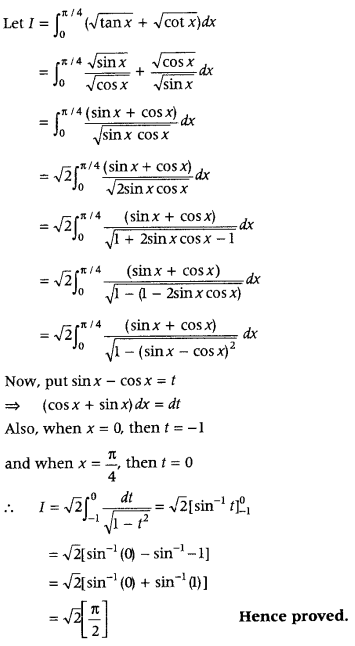
Question 64
Answer:
Question 65.
Evaluate
Answer: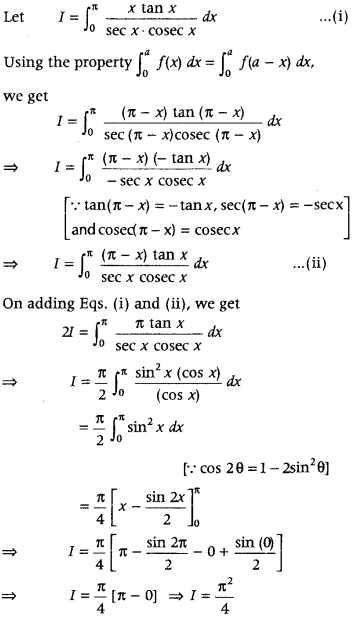
Question 66.
Evaluate
Answer: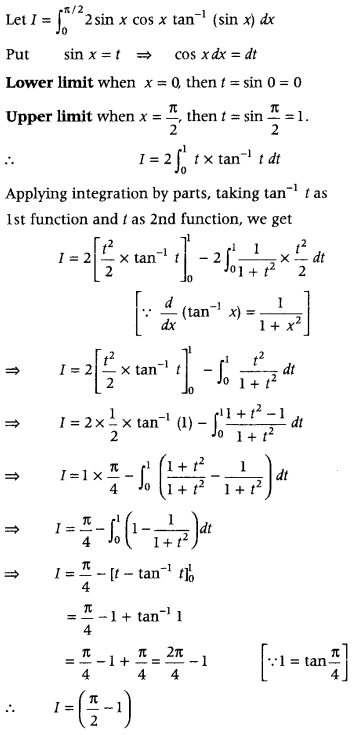
Question 67.
Evaluate
Answer:
Question 68.
Evaluate
Answer:
Given integral is
Here, a = 1, b = 4, f(x) = x2—x
and nh = b – a = 4 – 1 = 3
Now, f(a) = f(1) = (1)2 – (1) = 1 – 1 = 0
f(a + h) = f(1 + h)
= (1 + h)2 – (1 + h)
= 1 + h2 + 2h – 1 – h
= h2 + h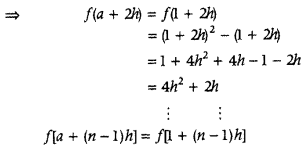
= [1 + (n – 1)h]2 – (1 + (n – 1)h]
= 1 + (n – 1)2 h2 + 2(n – 1)h – 1 – (n – 1)h
= (n – 1)2 h2 + (n – 1)h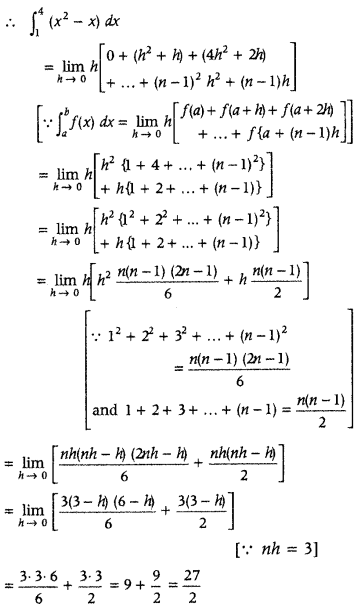
Question 69.
Evaluate
Answer:
4
Question 70.
Evaluate
Answer:
Hint: Here, a = 0, b = 2, nh = 2
Question 71.
Evaluate
Answer:
Question 72.
Evaluate
Answer:
Question 73.
Evaluate
Answer:
34







0 Comments